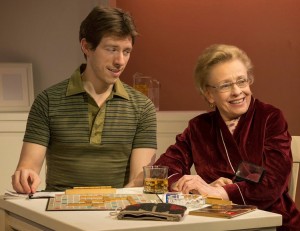It’s no wonder that with a cast of 35, the production of Nicholas Nickleby, A New Musical was forced to skimp on quality in other areas. This musical was based on Charles Dickens’ 1830’s novel and was presented by the Crummles Troupe as they tell the story of the Nickleby family. Young Nicholas Nickleby, played by the not-so-teenage looking Douglas McDonnell, is left penniless when his father passes away. Soon after, his cruel Uncle Ralph (William Broderick) sends him away to earn a living as a teacher at The Squeers’ boarding school. This “boarding school” is reminiscent of Miss Hannigan’s orphanage — poor conditions and cruel owners (played by Luba Mason and David F. Slone) shock Nicholas, and leave him with no choice but to escape with crippled boy Smike (Jonathan Fox Powers) and return home, where the family bands together against Uncle Ralph.
Unfortunately, for every strength of this production (which are quite a few), there was a disappointment. The story itself is strong, and I found myself, quite possibly for the first time ever, wanting to pick up a Charles Dickens book. However, the melodramatic way that the Crummles Troupe prides itself on presenting the plot is over the top and often downright annoying. The play within a play premise also works to make the characters one-dimensional, as you are constantly reminded that the actors on stage are playing two roles — they are not only acting as their role in Nicholas Nickleby, but acting as actors from the Crummles Troupe acting in Nicholas Nickleby.
With such a large cast, one would think the staging and choreography would have been less dull and wooden. Distracting throughout the performance were the six children who looked like they had been asked to perform the show after learning it that morning. But perhaps the most distracting weakness of the production was the make-up. Poor William Broderick. The make-up applied to make him look older was a disaster. The production also skimped on scenery and props.
The production featured original music and lyrics by Alaric Jans that worked for the time period of the show, as well as with the book by Robert Sickinger. That being said, you won’t find yourself humming along to any of these songs days later. With an ensemble of 35 strong voices blending together, the songs were often extremely enjoyable to listen to during the musical.
Though not a perfect piece by any means, Nicholas Nickleby, A New Musical, succeeds in entertaining audiences with a strong story, score and cast. Although 35 cast members may have been taking on too much, there’s something to be said for the fact that every seat in the theater was filled.
Top Photo Credit: Peter Welch Photography
































![London Wall 0404[1]](http://static1.squarespace.com/static/585832425016e17cbf7235be/587536246fd27cad3e63291a/58753b506fd27cad3e63af2b/1484077904518/London-Wall-04041.jpg?format=original)
![London Wall 218[1]](http://static1.squarespace.com/static/585832425016e17cbf7235be/587536246fd27cad3e63291a/58753b516fd27cad3e63af2e/1484077905455/London-Wall-2181.jpg?format=original)
![London Wall 025[1]](http://static1.squarespace.com/static/585832425016e17cbf7235be/587536246fd27cad3e63291a/58753b536fd27cad3e63af35/1484077907019/London-Wall-02511-300x199.jpg?format=original)


